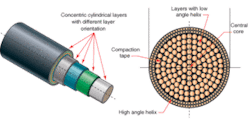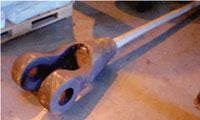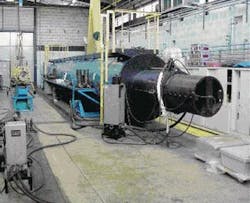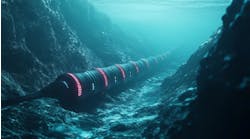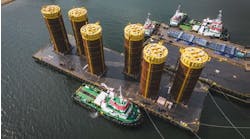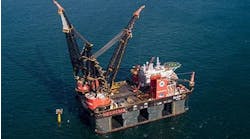Carbon fiber shows potential for deepwater, ultra-deep mooring
Testing confirms proof of concept
Dan Jackson, DeepSea Engineering, & Management Ltd., UK
Ricardo Teles, Petrobras, Brazil
Fergus Hines, Oceaneering Multiflex
Carbon fiber shows strong potential as a competitive deepwater and ultra-deepwater mooring product to replace steel, but work remains on validating its performance.
The main objectives in any study would be to ensure that carbon fiber moorings could reduce the vessel watch circle in deep and ultra-deepwater (extending operational capability), match the strength-to-diameter ratio of existing steel lines (extend an existing fleet capability), and achieve high-end termination efficiency. This was the driving force for a concept and feasibility study undertaken by DeepSea Engineering and Management Ltd.
The main purpose of the work was to investigate the use of carbon fiber for ultra-deepwater applications, most notably for mobile offshore drilling units (MODU) and permanent mooring applications in water depths to 3,000 m. It was anticipated that carbon fiber lines could withstand similar breaking loads to existing steel lines for the same diameter, thereby reducing the weight of a given line, in air, by one-fourth, and capable of being installed using an existing fleet of vessels with limited or no modification. The lines would be capable of competing on cost with steel and polyester. The main advantage over polyester would be line volume (smaller diameter for a given MBL than polyester), thereby reducing deployment and installation costs for a complete mooring system.
Illustration of the mooring line spiral strand design concept.
The study was a joint collaboration between DeepSea and Petrobras with financial support from the UK DTI. The development of a carbon fiber mooring line for MODU and permanent mooring applications is part of the Petrobras PROCAP 3000 program. Petrobras was the primary project sponsor responsible for defining the mooring line requirements and testing of the prototypes at their Cenpes facility in Rio de Janeiro and Sao Paulo University.
Other major engineering and financial contributions were made by Oceaneering International based in Houston, USA, for the fabrication of the line and procurement of auxiliary components associated with the manufacture of the prototype lines at their facility in Niteroi, Brazil. The University of Reading, UK, was sub-contracted by DeepSea and responsible for sub-element testing of the end termination. Millfield Group, UK, provided technical assistance with their proprietary wire rope potting compound, Wirelock, used in the end terminations. DeepSea Engineering’s role was the engineering design, modeling, and analysis as well as the program management.
The project’s first phase scope included the fabrication of three scale prototypes (180 metric ton capacity) for proof of concept testing that included a tensile break test, a tension-tension fatigue test and a bend test. The work associated with concept and design has been published and is referenced [1] and will not be duplicated in this paper.
Design summary
The 180-metric-ton scale lines can be analogized to spiral strand wire rope. Each layer was made up of a number of low angle helically wound carbon fiber pultruded rods. There are two outer layers comprising of higher angle helix carbon fiber pultruded rods.
The patented carbon fiber rope concept is based on a central core consisting of a parallel bundle of seven carbon fiber rods (six rods wrapped around a central rod). A further five layers of rods were helically wrapped around the central core. The helical twist was achieved during the manufacturing process. A compaction tape was applied between the layers. The finished lengths were appropriate to the inline test and bend test.
The end fittings on the mooring line were non-grooved open spelter sockets and the rods were potted using the propriety potting compound.
End termination
The effectiveness of the end termination was a key aspect of the overall mooring line design. At the outset, it was decided to use conventional Certex type sockets potted with a propriety wire rope potting compound. This was done to keep proof of concept costs low. However, it is an unconventional approach, because the mechanics of the end termination using carbon rods cannot be analogized to that of steel wire. A program of testing was undertaken at the University of Reading in the UK to investigate the behavior of the rods in the socket and evaluate a number of termination configurations. A successful test suggested that termination efficiency of greater than 70% could be achieved.
A modified “Z” armor laying machine was used to fabricate the line. Upon fabricating the line, the end termination was fitted and testing could commence.
Rupture and fatigue test chamber at CENPES.
Three tests were proposed for the 180-metric-ton line: In-line tension break test, tension-tension fatigue test, and cyclic bend test. The first test was the in-line tensile rupture test. The value obtained from this test established the performance criteria for the Tension-tension fatigue test and the cyclic bend test.
A visual inspection of the line to be tested was carried out prior to testing. The line was wrapped in the tape layer for transportation, although this is not a prerequisite of the manufacture. The line looked in good order and no damage was noted.
During the in-line rupture test, a loud noise was heard suggesting failure of the line at 174 metric tons of force (96.7% of the design load). The test was stopped and the line removed for inspection. The line did sustain some initial damage, but interestingly, the damage was not catastrophic and it was thought that the line could withstand more than the 174-metric-ton load. Unfortunately, owing to testing constraints, there was not time to re-test the sample to catastrophic failure.
During loading and removal of the test line from the chamber, it was noted that the line could easily bend under its own weight. While only an observation, it did dispel the idea that the line would not adequately bend.
The second line was set up for the tension-tension fatigue test in the same chamber as the previous in-line rupture test. It was proposed that 80,000 cycles would be comparable to steel spiral strand. However, in the light of the tensile test success, the engineers at Cenpes extended the fatigue test to 140,000 cycles. This number is greater than the API mean fatigue curve for common link chain (135,200 cycles for 30% of the minimum breaking load). The fatigue test loads are 10% (17 metric tons) to 40% (70 metric tons) of the tensile break load (174 metric tons). After successful completion of the revised fatigue test the rope broke at 205 metric tons of force.
Bend Test
This test is pending at the time of writing.
The results summary table summarizes the results of the testing protocol.
Conclusions
The tests on lines 1 and 2 met the main aim of establishing the mooring line proof of concept. The first test, an in-line tensile rupture test, provisionally failed at 174 metric tons. The target was 180 metric tons, although the failure was not catastrophic. The second test, a cyclic fatigue test, met the 140,000 cycles and the rope then went on to break in an in-line rupture test at 205 metric tons, the target was 180 metric tons.
From the technical perspective of design, manufacture and testing the project exceeded expectations. The design and modeling approach developed by DeepSea predicted with good accuracy the failure point of the ropes. The testing undertaken at The University of Reading saw the end termination efficiency rise from 23% to 76 % in a few well planned experiments.
The manufacture of the lines was semi-automated as opposed to manual lay-up, as originally planned. The manufacturing process successfully produced the prototypes and gives a very good bench mark for further development.•
Acknowledgements
DeepSea would like to thank Petrobras for their attitude to new technology and their valuable technical contributions, as well as financial support and sponsorship of this project. The role of Oceaneering International Inc. and their facility in Brazil (Marine Production Systems do Brasil) was invaluable to the success of the project.
References
Jackson, D., Shepheard, B., Kebadze E., Teles, R., Rossi, R., Célio, R., “CFRP Mooring Lines for MODU Applications”, Deep Offshore Technology Conference, (DOT) 2004

